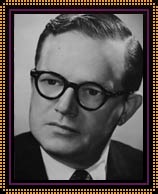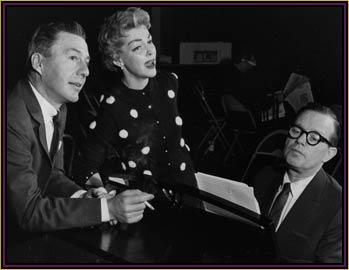 Brilliant, prolific tunesmith who, over the course of a nearly 75-year long career, composed 2,000 songs, published 1,500 of them, and had somewhere around 200 of them become enormous hits or later song standards.
Brilliant, prolific tunesmith who, over the course of a nearly 75-year long career, composed 2,000 songs, published 1,500 of them, and had somewhere around 200 of them become enormous hits or later song standards.
Jule (pronounced JOO-lee) Styne was playing solo piano with the Chicago Symphony at age eight, worked during the Jazz Age in bands, which also featured the up-and-coming likes of Benny Goodman, Glenn Miller, and Charlie Spivak, and entered films in the 1930s as an arranger and vocal coach for Alice Faye and Shirley Temple at 20th Century-Fox. Styne next worked for Republic Pictures on melodies for various B musicals, and in the early ’40s began his famous, though never exclusive, partnership with lyricist Sammy Cahn. Some of Styne and Cahn’s biggest hits during the ’40s and ’50s were sumptuous romantic ballads, many of which Frank Sinatra helped propel to the top of the weekly Hit Parade. One example was the lovely “I Fall in Love Too Easily” from the film ANCHORS AWEIGH (1945), while another, the lush title song from the feature THREE COINS IN THE FOUNTAIN, also won an Oscar as Best Song in 1954.

David Wayne, Vivian Blaine, and Jule Styne, playing the piano, during a rehearsal for "Say, Darling."
The early Styne songs, full of wartime longing and nostalgia, often seem atypically softer and gentler than his later sharp, showbizzy Broadway anthems like “Everything’s Coming Up Roses” and “Let Me Entertain You” from “Gypsy” (1959), or “Don’t Rain on My Parade” from “Funny Girl” (1964). Even a later ballad like “People” (from “Funny Girl”), which became a song standard for Barbra Streisand, has more brass than, say, “It’s Magic,” a rich number from the film ROMANCE ON THE HIGH SEAS (1948), which became another signature tune for an equally feisty song stylist, Doris Day. Still, the sense of rhythmic and melodic flow remained a constant, as did the craftsmanship of a song’s syncopation and drive as well as the sensitivity to lyrics and emotion. If Styne often did not have the star clout on Broadway in the ’50s that Jerome Kern, Irving Berlin, and Cole Porter did a generation earlier, it was partly because, as he himself realized, “I am the greatest collaborator there is,” often letting a show’s star or a musical’s lyricist set much of the tone for his work.
Although Styne wrote a number of classic songs especially for film, including “(It Seems to Me) I’ve Heard that Song Before” from “Youth on Parade” (1942) and “I’ll Walk Alone” from TONIGHT AND EVERY NIGHT (1945) and lent his talent for infectious, buoyant melodies to such film scores as ANCHORS AWEIGH (1945), THE KID FROM BROOKLYN (1946), and IT HAPPENED IN BROOKLYN (1947), he preferred writing for the stage. He first took a crack at writing a full Broadway score with “High Button Shoes” (1947) — the result, with choreography by Jerome Robbins, was a Broadway landmark. His encore triumph came in collaboration with snappy, witty lyricist Leo Robin, “Gentleman Prefer Blondes” (1949), which gave Carol Channing an enduring theme song with the delicious “Diamonds Are a Girl’s Best Friend.”
Jule Styne
- "Bells Are Ringing"
- "Do Re Mi"
- "Funny Girl"
- "Gentlemen Prefer Blondes"
- "Gypsy"
- "Hallelujah, Baby!"
- "Peter Pan"
- "Sugar"
- Carol Channing
- Marvin Hamlisch
- Angela Lansbury
- Arthur Laurents
- Mary Martin
- David Merrick
- Cole Porter
- Chita Rivera
- Jerome Robbins
- Stephen Sondheim
- Barbra Streisand
- Elaine Stritch
Styne would collaborate with Robin on the bright score for the Betty Grable film MEET ME AFTER THE SHOW (1951) and the less successful feature remake MY SISTER EILEEN (1955) and would create tunes with Cahn for THE WEST POINT STORY (1950), but around mid-decade he firmly decided to commit his songwriting energies to Broadway rather than to film. His work with Cahn came to an end as a result, but a recurring collaboration with the playful, inventive duo of Betty Comden and Adolph Green began with a revue “Two on the Aisle” (1951) and would later include the charming “Bells Are Ringing” (1956). Through the late ’60s, Styne’s genius for writing slam-bang Broadway hits for strong leading women came to the fore; one not only links Channing with “Gentleman” and Streisand with “Funny Girl,” but also Judy Holliday with “Bells,” Mary Martin with “Peter Pan” (1954), featuring the famous “Never Never Land”) and Ethel Merman with “Gypsy” (1959), which includes the powerhouse anthem “Rose’s Turn.”
Although Styne always felt he had more creative freedom on Broadway, most of his major musicals were eventually adapted for the big screen. Beginning in 1957 with a musicalization of RUGGLES OF RED GAP, he also began writing (and later producing) TV musical programs as well. The ’60s had its leaner moments (“Do Re Mi,” “Subways Are for Sleeping,” both 1960 Broadway shows), but, besides “Funny Girl,” this era also saw Styne finally win Tony Awards for his high energy “Hallelujah, Baby!” (1967). He continued with shows like “Sugar” (1972) and “Lorelei” (1974) and created tunes for the Broadway musical rendition of “The Red Shoes” (1993) less than two years before he died.
A stocky, feisty man much loved in showbiz circles for his sputtered, incomplete sentences, his wit, adaptability and showmanship, Styne was a lively interview subject and sometime performer up until the end. The creator of songs ranging from the joyous “Let It Snow! Let It Snow! Let It Snow!” and “Make Someone Happy” to the heartbreaking melancholy of “Guess I’ll Hang My Tears Out to Dry” to the triumph of “Just in Time” received many deserved honors before his death at age 88.
Source: Excerpted from Baseline. BaselineStudioSystems — A Hollywood Media Corp. Company.
Photo credits: Photofest

